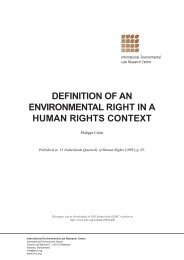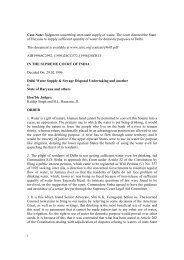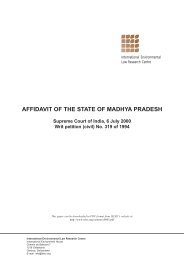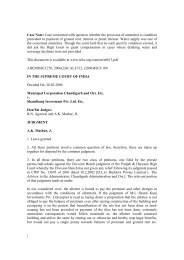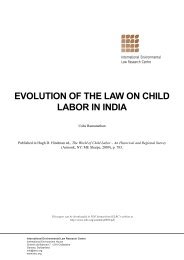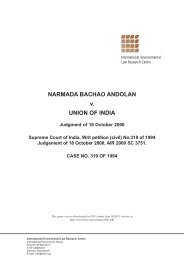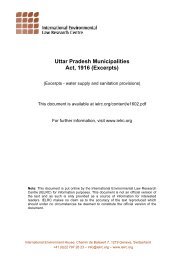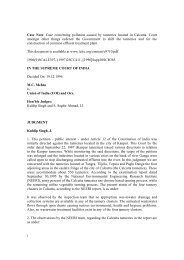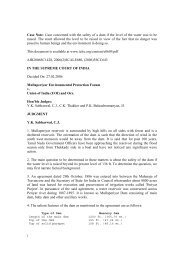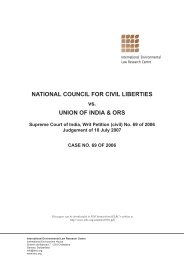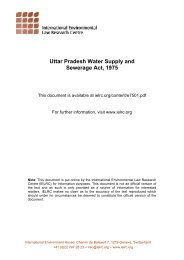IELRC.ORG - Janardan Ganesh Khadilkar v. Ravi Bhikaji Kondkar
IELRC.ORG - Janardan Ganesh Khadilkar v. Ravi Bhikaji Kondkar
IELRC.ORG - Janardan Ganesh Khadilkar v. Ravi Bhikaji Kondkar
- No tags were found...
Create successful ePaper yourself
Turn your PDF publications into a flip-book with our unique Google optimized e-Paper software.
westernmost embankment coloured red on the map in the suit, and then bifurcatingalmost at right angles east and west. The map is not so helpful as it might be. It containsno scale and no compass bearings, and only shows a portion of the river, viz., that to theeast of the embankment I have mentioned. It is on the site of this embankment that thewater has hitherto been taken. The embankment itself was only built some eighteen yearsago but the findings are that the plaintiff then pierced this embankment so as to admit ofthe water flowing as before, and that the pipe he subsequently placed for that purpose wasa hollowed palm tree which he subsequently renewed. It was then that the defendantsobstructed the pipe and the flow of water for the first time, and consequently this actionwas brought. The embankment I have referred to is called "the dam in dispute" in theCourt of first instance, and must not be confused with the dam which from time to timehas been placed by the plaintiff and others in the river bed itself so as to ensure a supplyof water in time of drought or scarcity.5. The technical difficulty here is that the water has been brought not in a defined channelbut has been allowed to spread over and irrigate the defendants' lands first and then theplaintiff's. This indeed appears to be a common method of irrigation in India see VilluriAdinarayana v. Polimera Ramudu 17 Ind. Cas. 648 : 37 M. 304 at p. 306 : 12 M.L.T. 637: 24 M.L.J. 17. It has at any rate been the method adopted for very many years forirrigating the paddy fields in dispute in the present case. Accordingly the contention ofthe defendants that the plaintiff's right, if established, "would tend to the total destructionof the defendants' property" within the meaning of Section 17(a) of; the Indian EasementsAct may be summarily dismissed.6. The defendants' substantial objection is that the right claimed is really one "to surfacewater not flowing in a stream" and hence cannot be acquired as an easement under theIndian Easements Act [see Section 17(c)], nor be the-subject of a presumed lost grant. Inmy judgment that is not really the right which the plaintiff is claiming. He is reallyclaiming the right to take the water from the river without interruption by the defendants,and to have it conveyed over their lands. According to the Court of first instance theplaint alleges that "from the time of his ancestors the plaintiff has been in the habit oftaking the water of that river for irrigating his lands'." The plaint then proceeds to givedetails as to how that water is taken and reaches plaintiff's lands.7. Some difficulty was caused by the fact that a large portion of the embankment inquestion appears to be on land belonging to Government, and not to the defendants asthey alleged, The Collector, however, does not appear to lake any objection, and so far asthe present parties are concerned, I do not know that the point is really very material.Defendant No. 3 is now the Government tenant but has been warned not to obstruct theplaintiff in taking the water.8. If, then, my view of the facts is correct, the claim is to river water and not to meresurface water on the defendants' lands and consequently Section 17(c) does not apply.9. It is no doubt true that the method of conveying that river water over the defendants'lands creates a difficulty, for some is used to irrigate the defendants' lands or may be lost2



